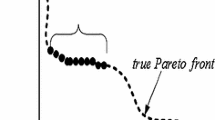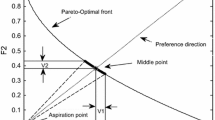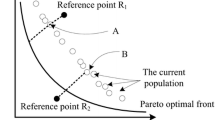Abstract
Preference information (such as the reference point) of the decision maker (DM) is often used in multiobjective optimization; however, the location of the specified reference point has a detrimental effect on the performance of multiobjective evolutionary algorithms (MOEAs). Inspired by multiobjective evolutionary algorithm-based decomposition (MOEA/D), this paper proposes an MOEA to decompose the preference information of the reference point specified by the DM into a number of scalar optimization subproblems and deals with them simultaneously (called MOEA/D-PRE). This paper presents an approach of iterative weight to map the desired region of the DM, which makes the algorithm easily obtain the desired region. Experimental results have demonstrated that the proposed algorithm outperforms two popular preference-based approaches, g-dominance and r-dominance, on continuous multiobjective optimization problems (MOPs), especially on many-objective optimization problems. Moreover, this study develops distinct models to satisfy different needs of the DM, thus providing a new way to deal with preference-based multiobjective optimization. Additionally, in terms of the shortcoming of MOEA/D-PRE, an improved MOEA/D-PRE that dynamically adjusts the size of the preferred region is proposed and has better performance on some problems.














Similar content being viewed by others
Explore related subjects
Discover the latest articles, news and stories from top researchers in related subjects.References
Ahmed F, Deb K (2013) Multi-objective optimal path planning using elitist non-dominated sorting genetic algorithms. Soft Comput 17(7): 1–17
Bastos-Filho CJ, Chaves DA, Pereira HA, Martins-Filho JF (2011) Wavelength assignment for physical-layer-impaired optical networks using evolutionary computation. J Opt Commun Netw 3(3):178–188
Ben Said L, Bechikh S, Ghdira K (2010) The r-dominance: a new dominance relation for interactive evolutionary multicriteria decision making. IEEE Trans Evol Comput 14(5):801–818
Coello CAC, Lamont GB (eds) (2004) Applications of multi-objective evolutionary algorithm. World Scientific, USA
Corne D, Dhaenens C, Jourdan L (2012) Synergies between operations research and data mining: the emerging use of multi-objective approaches. Eur J Oper Res 221(3):469–479
Cvetkovic D, Parmee IC (1999) Genetic algorithm-based multi-objective optimisation and conceptual engineering design. Evolutionary computation, 1999. CEC 99. In: Proceedings of the 1999 Congress on IEEE, 1
Cvetkovic D, Parmee IC (2002) Preferences and their application in evolutionary multiobjective optimization. IEEE Trans Evol Comput 6(1):42–57
Das I, Dennis JE (1998) Normal-boundary intersection: a new method for generating the Pareto surface in nonlinear multicriteria optimization problems. SIAM J Optim 8(3):631–657
Davarynejad M, Vrancken J, van den Berg J, Coello CAC (2012) A fitness granulation approach for large-scale structural design optimization. Variants of evolutionary algorithms for real-world applications. Springer, Berlin Heidelberg, pp 245–280
Deb K, Pratap A, Agarwal S, Meyarivan TAMT (2002) A fast and elitist multiobjective genetic algorithm: NSGA-II. IEEE Trans Evol Comput 6(2):182–197
Deb K, Thiele L, Laumanns M, Zitzler E (2005) Scalable test problems for evolutionary multiobjective optimization. Springer, London
Deb K (2008) Multi-objective optimization using evolutionary algorithm. Wiley, UK
Deb K, Kumar A (2007) Light beam search based multi-objective optimization using evolutionary algorithms. Evolutionary computation, (2007) CEC 2007. IEEE Congress on IEEE, pp 2125–2132
Deb K, Sundar J Udaya Bhaskara Rao N, Chaudhuri S (2006) Reference point based multi-objective optimization using evolutionary algorithms. Int J Comput Intell Res 2(3):273–286
Deb K, Thiele L, Laumanns M, Zitzler E (2002) Scalable multi-objective optimization test problems. In: Proceedings of the congress on evolutionary computation (CEC-2002), (Honolulu, USA), pp 825–830
Durillo JJ, Nebro AJ (2011) jMetal: a Java framework for multi-objective optimization. Adv Eng Softw 42(10):760–771
El-Hefnawy NA (2014) Solving bi-level problems using modified particle swarm optimization algorithm. Int J Artif Intell 12(2):88–101
Fard HM, Prodan R, Barrionuevo JJD, Fahringer T (2012) A multi-objective approach for workflow scheduling in heterogeneous environments. In: Proceedings of the 2012 12th IEEE/ACM international symposium on cluster, cloud and grid computing (ccgrid 2012). IEEE Computer Society, pp. 300–309
Fonseca CM, Fleming PJ (1995) Multiobjective genetic algorithms made easy: selection sharing and mating restriction
Ishibuchi H, Tsukamoto N, Nojima Y (2008) Evolutionary many-objective optimization: a short review. In: IEEE congress on evolutionary computation. pp 2419–2426
Jaszkiewicz A, Slowinski R (1999) The ’Light Beam Search’ approach can overview of methodology applications. Eur J Oper Res 113(2):300–314
Li K, Kwong S, Cao J, Li M, Zheng J, Shen R (2012) Achieving balance between proximity and diversity in multi-objective evolutionary algorithm. Inf Sci 182(1):220–242
Li M, Yang S, Liu X (2014) Shift-based density estimation for pareto-based algorithms in many-objective optimization. IEEE Trans Evol Comput 18(3):348–365
Li M, Yang S, Zheng J, Liu X (2014) Etea: a euclidean minimum spanning tree-based evolutionary algorithm for multi-objective optimization. Evol Comput 22(2):189–230
Li M, Yang S, Liu X, Shen R (2013) A comparative study on evolutionary algorithms for many-objective optimization. Evolutionary multi-criterion optimization. Springer, Berlin Heidelberg, pp 261–275
Metaxiotis K, Liagkouras K (2012) Multiobjective evolutionary algorithms for portfolio management: a comprehensive literature review. Expert Syst Appl 39(14):11685–11698
Miettinen K (1999) Nonlinear multiobjective optimization. Springer Science and Business Media
Molina J, Santana LV, Hernndez-Daz AG, Coello CAC, Caballero R (2009) g-dominance: reference point based dominance for multiobjective metaheuristics. Eur J Oper Res 197(2):685–692
Precup RE, David RC, Petriu EM, Preitl S, Paul AS (2011) Gravitational search algorithm-based tuning of fuzzy control systems with a reduced parametric sensitivity[M]//Soft Computing in Industrial Applications. Springer, Berlin Heidelberg, pp 141–150
Scruggs JT, Cassidy IL, Behrens S (2012) Multi-objective optimal control of vibratory energy harvesting systems. J Intell Mater Syst Struct 23(18):2077–2093
Serdio F, Lughofer E, Pichler K, Buchegger T, Efendic H (2014) Residual-based fault detection using soft computing techniques for condition monitoring at rolling mills. Inf Sci 259:304–320
Sindhya K, Deb K, Miettinen K (2011) Improving convergence of evolutionary multi-objective optimization with local search: a concurrent-hybrid algorithm. Nat Comput 10(4):1407–1430
Van Veldhuizen DA, Lamont GB (1998) Evolutionary computation and convergence to a pareto front[C], Late breaking papers at the genetic programming, (1998) conference. Stanford University Bookstore, University of Wisconsin, Madison, Wisconsin, USA, pp 221–228
Wagner T, Beume N, Naujoks B (2007) Pareto-, aggregation-, and indicator-based methods in many-objective optimization. Evolutionary multi-criterion optimization. Springer, Berlin Heidelberg, pp 742–756
Zhang Q, Li H (2007) MOEA/D: a multiobjective evolutionary algorithm based on ecomposition. IEEE Trans Evol Comput 11(6):712–731
Zitzler E, Deb K, Thiele L (2000) Comparison of multiobjective evolutionary algorithms: empirical results. Evol Comput 8(2):173–195
Zitzler E, Thiele L, Laumanns M, Fonseca CM, Da Fonseca VG (2003) Performance assessment of multiobjective optimizers: an analysis and review. IEEE Trans Evol Comput 7(2):117–132
Zitzler E, Laumanns M, Thiele L (2002) SPEA2: improving the strength Pareto evolutionary algorithm for multiobjective optimization. In: Proceeding of optimisation control, Evol. Methods Des., pp 95–100
Acknowledgments
This work was supported by the research Projects: the National Natural Science Foundation of China under Grant Nos. 61379062, 61372049, the Natural Science Foundation of Hunan Province under Grant No. 14JJ2072, the National Natural Science Foundation of China No. 61403326, the Science and Technology Project of Hunan Province under Grant No. 2013SK3136, the Graduate Innovation Foundation of Hunan Province of China under Grant No. CX2013A011, the Key Research Project of Education Department of Hunan Province under Grant No. 12A135, and the Science and Technology Plan of Hunan Province of China under Grant No. 2014GK3027.
Author information
Authors and Affiliations
Corresponding author
Additional information
Communicated by V. Loia.
Rights and permissions
About this article
Cite this article
Yu, G., Zheng, J., Shen, R. et al. Decomposing the user-preference in multiobjective optimization. Soft Comput 20, 4005–4021 (2016). https://doi.org/10.1007/s00500-015-1736-z
Published:
Issue Date:
DOI: https://doi.org/10.1007/s00500-015-1736-z




